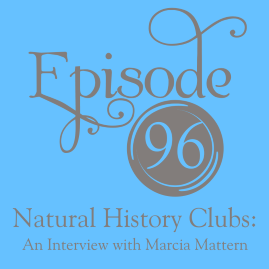
Listen Now:
“The sky, the sun, rivers, trees, animals and flowers are to children a subject of ever-increasing wonder and speculation, and what we desire, who have the question of the right guiding and training of the young eager mind so much at heart, is, above all things, to make this power of wonder, this spirit of enquiry, a durable and life-long possession, so that whatever else may fail the children in the course of years, the love and healing of Nature may be a priceless treasure to them for ever. … To this end, certain branches of the P.N.E.U. have formed Natural History Clubs so that some sort of systematic and continuous work might be accomplished, and the interest of the children stimulated and encouraged by the means of many working together towards some definite end.” P.N.E.U. Natural History Clubs by F. Blogg
Marcia Mattern’s Scaffolding example (See Sidebar for 2 more)
Marcia’s post on Natural History Clubs
ADE Interview with John Muir Laws, Part I



I was wondering if I could get a copy of her nature journal bookmark? I am enthralled by this! Thank you so much for doin ? This I review and sharing so much wonderful information <3
I’ll write a blog post and include the two different kinds of bookmarks we use in our house for our Nature Journals.
I would also love a copy of the bookmark. This episode was so helpful. I would also love to see more examples/instructions on how to make the nature notebook more of a “narrative” rather than primarily about the drawings. As my kids move into their teen years I think that just drawing a picture of something they see if not challenging them enough. I would love to see examples of a “narrative” page of a nature notebook…
I will post some pictures of some examples from the Armitt (the archives of Charlotte Mason in Ambleside) as well as some from our Nature Journals on my blog soon!
I loved this episode, thank you! But I do have a question – I’m having trouble understanding how this would work when each family is doing something different for special studies. Do you just pick an additional special study for natural history club? Or does everyone know ahead of term planning what you will be studying and plan their special studies accordingly?
mks, You are welcome to see my link of scaffolding that I use for Natural History Clubs. This allows families to have some shared special studies. HTH.
Fabulous interview, ladies! Thank you for all of the inspiration, ideas, and encouragement!
We are glad you enjoyed it, Ashley. Marcia has so much wisdom to share in this and many other areas.
~Nicole
Thank you Nicole and Marcia! I guess it’s better late than never in listening. I did have a question in reference to Marcia’s link above about Natural History Clubs. When she made a reference to getting together and walking and finding interesting things to identify. I know you have field guides so are you looking for exact names? I get confused on the topic of identification and how much time can should/can be spent on that. Thanks, Elizabeth
Elizabeth,
Naming is not as important as knowing. Once we name something, our mind stops asking questions, and that is not what we want with a growing interest in learning nature. Mason said it was better to know all about a plant or animals ways. The name, in fact, can be the easiest part and easily checked at home later.
Liz